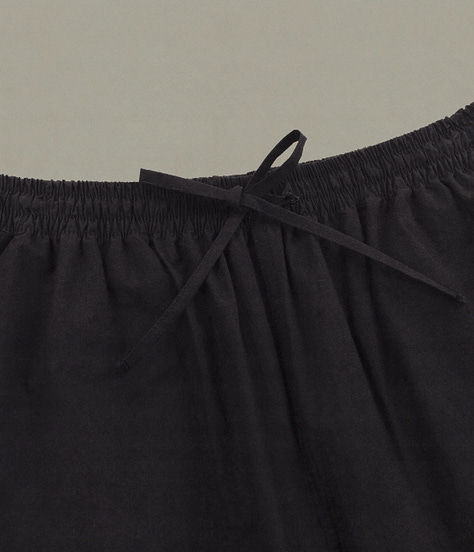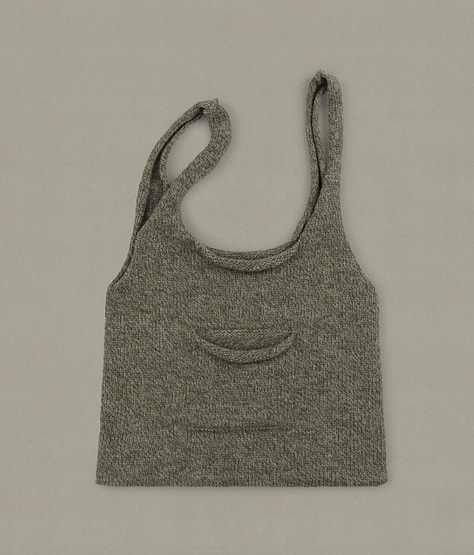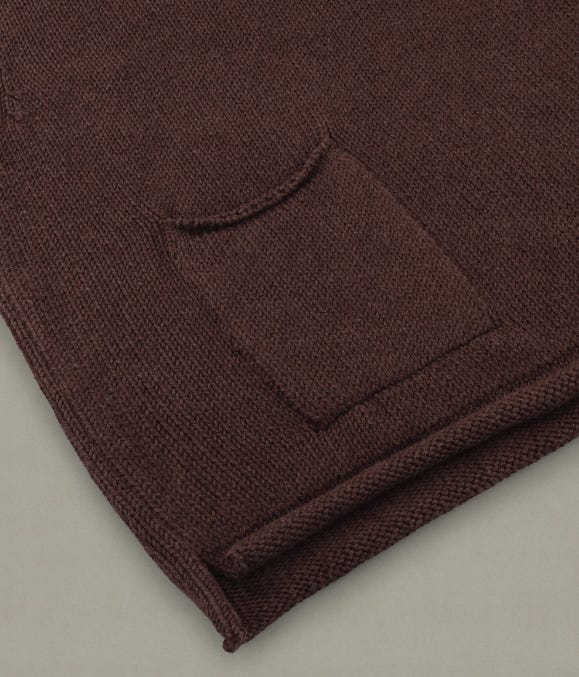Xenia Telunts was born in Moscow, Russia. She graduated from the London College of Fashion in 2017, the same year in which she founded her eponymous brand. Now presenting their eleventh seasonal collection, XENIA TELUNTS is about effortless and hard-wearing utilitarian clothing that is gender-neutral, sustainable and conscious. The brand’s garments are produced locally by UK laborers earning a fair wage, making use of organic materials and natural dyes as well as low- to zero-waste pattern cutting techniques.
XENIA TELUNTS keeps a low-key digital presence. There’s a beautiful website — designed by RELATIVELY GOOD studio — that presents the brand’s clothes and accessories in a simple and elegant way. There’s also an Instagram page which occasionally offers behind-the-scenes looks at their slow and conscious design process. These give a sense of the amount of care and attention they put into each aspect of what they do. One example: the brand used handwritten care labels tying items to a code that could be entered on their website to order spare parts or request maintenance. Another example: items from the latest collection come with incense garment tags, made in-house, which can be burnt to release a cedar wood/patchouli scent. One more: drawing inspiration from Soviet graphic design, every knitwear order comes with a vintage badge, sourced in Ukraine.


Once a one-woman brand, XENIA TELUNTS is dedicated to conscious, slow and organic growth. “I learned to be patient,” Telunts said in a recent interview with HIGHSNOBIETY. She is well aware that their focus on very small collections, combined with a wariness of fashion calendars, is “not a quick route to commercial success. But I hope that it builds the foundation for a brand that can still be relevant in years to come.” This ethos reflects the kind of durable wardrobe one would have if it consisted entirely of XENIA TELUNTS’ ‘Fisherman Sweaters’, ‘Restful Pants’, ‘Quilt Jackets’ and ‘Wool Shopper Bags’.






I’ve been following XENIA TELUNTS for one or two years now, impressed by the way in which they create their own unique kind of heritage-inspired, forward-looking timelessness. The aesthetic is traditional, yet contemporary. The approach is age-old, yet modern. It’s as if the brand strips all the layers of identity, fashion, hype, and commerce to get to the core of what a piece of clothing is: a life companion. However simple that may sound, it’s an impressive feat.

PRESENT FOREVER (PF): XENIA TELUNTS was founded in 2017. You mentioned somewhere in an interview that you launched it in the summer you graduated from the London College of Fashion. Do you recall what it was that made you decide to start your own brand then and there? Can you call to mind the decisive moment — an item you made, a dream you had, a vision you desired to realize?
XENIA TELUNTS (XT): It’s true, the brand “began” with my graduation collection [for the BA Womenswear, PF] from LCF. It happened very organically. I must admit, I never saw myself as someone who would have their own brand.
My plan was to get a job (which hopefully paid enough) and continue accumulating experience from the industry. However, right after the Graduation Show, I received an email from a store in Japan expressing their interest in seeing the collection in person and possibly carrying it in their store. He came, loved the pieces, and ordered a few. Realising it was an opportunity not to be missed, I left London and set up my studio in an old stable yard in the north of England, without having to pay rent. This allowed me to use the small amount of money I had to buy the materials and equipment needed to make the order. I just took it step by step, thinking: “Well, if nothing happens after this order is delivered, I will just continue with my original plan of looking for jobs in the fashion industry.” I had the privilege of designing and bringing to life pieces of clothing that I loved and believed in, without having to compromise on materials and their ethical sourcing.
The first collection was received really well in Japan, and soon there was more interest from other stores in Tokyo and other cities. This experience was unique and valuable.
PF: XENIA TELUNTS has so far presented around twelve seasonal collections. I would like to briefly reflect on aspects of the brand’s development over the course of this period…First of all, a simple-minded question: What do you like most about the whole process of creating a collection?
XT: For me each collection is a journey of exploration and research into vintage garments, materials, and manufacturing methods we may not have used before. As a product developer and designer, I find the most valuable aspect of having my own brand to be process of discovering something amazing and then developing it into a cohesive piece. It’s like putting together a puzzle: starting with the vintage reference, then the shape, followed by the materials and hardware. Sometimes, the piece begins with a single button I’ve sourced, and the rest of the decision-making process revolves around it — determining the best historical references, the most complementary materials, and ensuring they don’t “overwhelm” the design. Creating collections allows me to grow both as a designer and a researcher.
PF: From the start, in 2017, your focus has been on wearable gender-neutral garments inspired by the heritage of hard workers — from fishermen to farmers. What made you decide to make gender-neutral items? And what is it about workers’ culture that makes it so inspiring for your designs? (As a Dutchman, I’m eager to hear how you managed to find inspiration in traditional Dutch Volendam pants…)
XT: I’ve always viewed clothing as a utility, aiming to create long-lasting, high-quality products using the simplest means possible. I find inspiration in people who, with limited resources, need garments to keep them warm and safe outdoors. Vintage garments are particularly intriguing to me because they often feature untreated cloth, showcasing the ingenuity of the past when advanced technologies weren’t available. Discovering materials like natural wax cotton or tightly woven canvas that repel rain is especially inspiring.
I always prioritize sustainability while keeping it simple. A 100% wool sweater, if treated and washed correctly, is with you for life. If it’s a classic silhouette and a neutral colour, there will never be a necessity to replace it. That’s where I see true sustainability: people having just a few items and wearing them for years. I strongly believe in hand-me-downs: the sentimentality of such acts is a core approach to sustainability. No matter how sustainable or ethically a product was made, if it ends up in a landfill, it was all a waste.
The same naturally applies to clothing being gender-neutral. Historically, families shared clothes and reused them as much as possible. The lack of modern-day overabundance led people to being resourceful with their clothing and using it for as long as possible.
Since my university days, I’ve been captivated by Volendam pants. Their shape and silhouette, especially when combined with materials like poplin or canvas cottons, which are stiff and hold their shape well, intrigue me. I read somewhere that fisermen wore such wide trousers for buoyancy if they fell overboard, which reinforces my belief that using simple materials can create something functional and durable.
PF: Every season you return to certain designs, which have developed into the brand’s signature staples, like the ‘Restful Pants’ or ‘Fisherman Sweater’. What benefits does it have, creatively speaking, to work this way — making ever-changing iterations of a similar design?
XT: “Less is more” is a belief I continuously return to. As a small, almost microscopic brand, we are known for our fisherman sweaters and wide-leg pants. I strive to perfect these core items every time we update them. Product development is central to our mission, and I find great satisfaction in ensuring we offer the best product possible at any given time, one that we are proud of and that people actually wear. While we do offer other styles and occasionally introduce something new, our core styles keep me focused on what the brand is truly about.





PF: Since the start of XENIA TELUNTS, the focus seems to have been on slow, organic growth. What does this ethos mean to you? And could you tell me what is needed to maintain and secure it within the current fashion climate?
XT: Slow growth is intentional growth. It’s about staying focused on what’s important to you and what you want to contribute to a world already overflowing with products. The world doesn’t need more clothes or more designers, so what message are you trying to convey with your designs, and what is your intention? That’s the basic ethos I follow.
PF: I’d now like to briefly zoom in on aspects of what I see as XENIA TELUNTS’ three core ambitions: sustainability, inclusivity and transparancy…
XT: …yes, so: Don’t overcomplicate it; strip back to the beginning of why clothes were made. The old principles are sometimes the best ones to look at; people weren’t distracted with social media and global reach. Make clothes using “clean” materials that don’t harm the planet or the people manufacturing them. Create clothing that most people can wear and tell your customer how you make it. It’s very simple.
PF: Many, if not all, of your items from the past seasons have been made in the UK. Some of your newest pieces, like the ‘V Neck Vest’, are made in India. Could you say a little bit about this decision? More specifically, could you tell me how it builds upon the ambition of working with (local) makers who make a fair living and also have sustainability at the core of what they do?
XT: Up until SS24, all of our products were made in the UK. The decision to move our cotton knitwear range to India was straightforward and logical. We work with an old family-run knitwear manufacturer, and the founder relocated to India, establishing his own factory there. Since the cotton yard used for our knitwear was originally imported from India, manufacturing it there reduced transporation emissions and minimized the steps in our supply chain.
We are very selective about the people who we choose to work with. I always ensure to visit the makers, spend time with them, and verify that not only can I trust them with making our products but also that their approach to their employees and the environment is ethical. Allowing the cotton range to be made in India wasn’t a risk for us, as it’s essentially the same family with the same approach and values.
PF: I’m always interested to hear how brands find a balance between different ambitions and values. Do you ever hit upon different decisions, in this regard/ For instance, do you ever experience a tension between making sustainable clothes and clothes that are made to be worn by anyone — insofar as the former can result in retail prices affordable only for relatively few people?
XT: Being a “slow” brand in a world of overconsumption is a struggle. To put it simply, cheap clothing has become the norm and is acceptable to most people due to its availability and price point, as well as the influence of social media, which leads to trends changing rapidly. But that wasn’t always the case.
I often tell the tale of my Soviet heritage, where resources such as cloth were really scarce. First of all, there was very little choice when the product or material was available. Secondly, people would usually buy just the fabric, as very few could afford the fully made garment, and they would then make it themselves. That kind of ingenuity is lost in the modern Western world, and people forget how much work goes into creating an item as simple as a shirt. So it takes time to gain a customer’s trust that our product is worth its RRP.
PF: Last but not least, I was wondering whether you could tell me what your personal favourite from XENIA TELUNTS’ upcoming collection is. What is it that makes it stand out for you?
XT: We are not developing a full new collection just yet. I want to slow down the cycle of putting out more collections and instead focus on what I find to be more important for the health of the brand, such as our manufacturing process and taking time to develop new products. For example, our scented swing tags took just under two years of development, experimentation, testing, and sourcing various materials to achieve the desired end product. We were constantly stopping and starting without being able to focus on just one thing and make it great. I want to be able to go into a deep focus on something specific, such as the garment dye methods of our t-shirts or working with naturally dyed yarn.
Apart from that, my favorite pieces at the moment are the ‘Summer Knits’ and ‘Restful Pants’ — I live in these.
PF: Thanks so much!
————————
For more content follow IG: @peacepilgrim89





